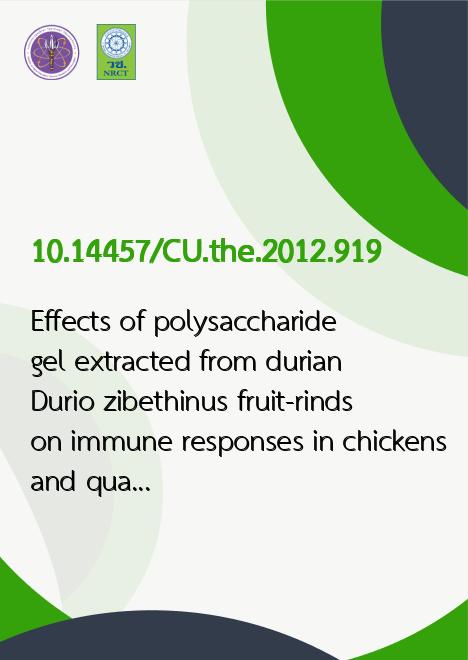
|
Effects of polysaccharide gel extracted from durian Durio zibethinus fruit-rinds on immune responses in chickens and quantity cholesterol in chicken nuscle |
|---|---|
| รหัสดีโอไอ | |
| Title | Effects of polysaccharide gel extracted from durian Durio zibethinus fruit-rinds on immune responses in chickens and quantity cholesterol in chicken nuscle |
| Creator | Nustha Kitprathaung |
| Contributor | Nattaya Ngamrojanavanich, Sununta Pongsamart, Niwat Chansiripornchai |
| Publisher | Chulalongkorn University |
| Publication Year | 2555 |
| Keyword | Polysaccharides, Durian, Chickens, Cholesterol, โพลิแซคคาไรด์, ทุเรียน, ไก่, โคเลสเตอรอล, ปริญญาดุษฎีบัณฑิต |
| Abstract | Polysaccharide gel (PG) from the fruit-rind of durian (Durio zibethinus Murr.) was studied. This study was to evaluate:(1) the effects of PG as a feed additive diet on body weight gain, fed conversion ratio (FCR), immune stimulation, total bacteria and Salmonella in feces and cholesterol levels in broilers. Eighty broiler chicks at one day of age were divided into 4 groups. Three experimental groups were fed a commercial diet coated with PG at 1, 2 and 3 g/100 g, respectively, and the control group was fed a commercial diet without PG. The study was performed for 42 days. Chicken weight gain and FCR in the treatment and control groups were not significantly different. The hemagglutination-inhibition (HI) antibody titers against Newcastle disease (ND) virus and ELISA antibody titers against the infectious bursal disease (IBD) virus were significantly different (P<0.05). The chickens fed the commercial feed added with 3 g/100 g PG revealed the highest titers against the ND and IBD antibodies than the other groups. There was no significant difference of heterophil:lymphocyte ratio between the treatment groups fed with PG and the control group fed without PG. Total bacteria counts in chicken feces were reduced and exhibited 81-97 % reduction in the experimental groups after feeding PG additive diet for 6 weeks. The Salmonella detected colonies were not found at week 6. Cholesterol levels in the plasma of chickens in the treatment and control groups were not significantly different. However, the cholesterol contents in the muscles of the broilers fed with 3% PG were significantly lower than the chickens fed without PG (P<0.05). (2) the effects of PG as a vaccine adjuvant. One hundred and sixty eight broilers were divided into 3 experimental groups. Three experimental groups were vaccinated with inactivated NDV vaccine containing PG at 0.5, 1.0 and 1.5 g/100 g vaccine; The study was performed for 55 days. The FCR in the negative control, positive control groups, the group received inactivated vaccine with 0%, 1.0% and 1.5% PG and the group were received commercial inactivated ND vaccine were not significant difference. The HI titers against ND virus showed at week 4 that HI titer in negative control, positive control and treated group injected with inactivated vaccine with 0, 0.5, 1.0 and 1.5% PG as well as commercial inactivated ND vaccine were not significant difference (P<0.05). At week 5, the HI titer values in negative and positive control group and treated group injected with 0.5 and 1% PG were not significant difference but significantly lower than those of group injected with 1.5% PG and commercial vaccine. The study found that the PG in diet benefited health promotion of broilers chickens in reduction fecal bacteria, immunostimulation and cholesterol reduction. PG can be used as a vaccine adjuvant to improve the immune system in chicken. |
| URL Website | cuir.car.chula.ac.th |